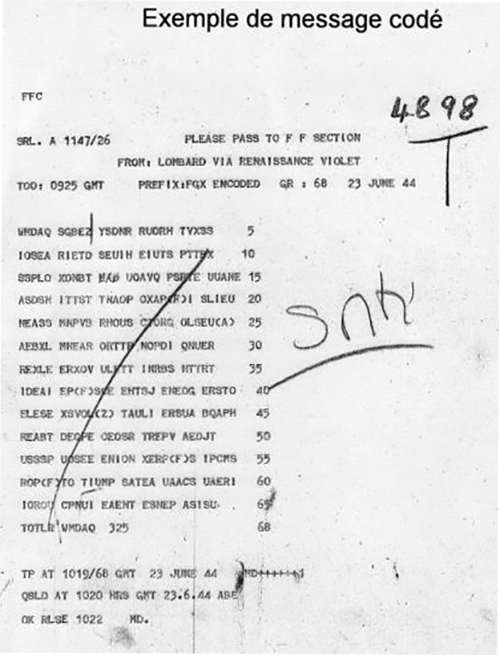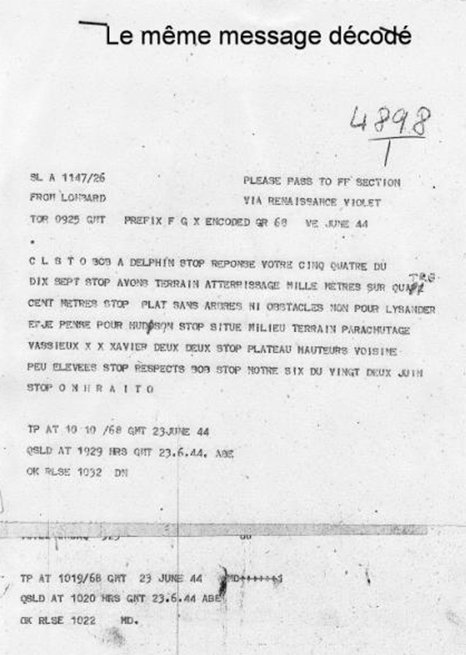Im Zweiten Weltkrieg verschickte ein französischer Widerstandskämpfer eine verschlüsselte Botschaft an einen unbekannten Empfänger. Der Klartext ist bekannt, das Verschlüsselungsverfahren nicht.
English version (translated with DeepL)
Über verschlüsselte Nachrichten der Résistance habe ich in den letzten Wochen bereits zweimal gebloggt. Der Grund: Über die Webseite “Musée de la résistance en ligne” (“Résistance-Museum online”) findet man eine ganze Reihe von chiffrierten Botschaften dieser Organisation. Für alle, die es noch nicht wissen: Als Résistance bezeichnet man die französische Widerstandsbewegung gegen die deutsche Besatzung im Zweiten Weltkrieg.
Auf die verschlüsselten Résistance-Nachrichten stößt man in einem Online-Archiv, das über die besagte Webseite zugänglich ist. Meist gibt es zum Klartext und zu den verwendeten Verschlüsselungsverfahren keine oder nur sehr allgemeine Angaben. Anscheinend hat sich bisher kein Krypto-Historiker mit diesen Kryptogrammen beschäftigt. Umso schöner, dass einige meiner Leser, darunter Norbert Biermann, ShadowWolf, Max Baertl, Gerd Hechtfischer, Matthew Brown und George Lasry nach meinen Artikeln etwas Licht ins Dunkel bringen konnten.
Eine Nachricht von 1944
Neben den insgesamt drei Résistance-Nachrichten, die ich bereits auf Cipherbrain vorgestellt habe, gibt es noch weitere, deren Betrachtung sich lohnt. Heute möchte ich auf eine verschlüsselte Nachricht eingehen, deren Klartext bereits bekannt ist. Allerdings habe ich keine Angaben zum Verschlüsselungsverfahren gefunden. Die Frage ist also in diesem Fall nicht, was verschlüsselt wurde, sondern wie verschlüsselt wurde.
Hier ist die verschlüsselte Nachricht:
Vermutlich handelt es sich um einen Funkspruch. Er ist auf den 23. Juni 1944 datiert. Als Absender ist “Lombard via Renaissance violet” angegeben, als Empfänger “FF Section”. Leider kann ich damit nichts anfangen. Vielleicht weiß ein Leser mehr dazu.
An gleicher Stelle findet man auch eine entschlüsselte Version dieser Nachricht:
Es geht hier anscheinend um eine Ortsbeschreibung. Vermutlich hat ein ortsansässiger Résistance-Kämpfer diese an einen Geheimdienst-Mitarbeiter geschickt, um mögliche Fallschirmabsprünge (“Parachutage”) vorzubereiten. Bevor es Google Maps gab, war es eine wichtige Aufgabe von Spionen, genaue Ortsbeschreibungen zu liefern.
Im Text kann ich die Namen “Lysander” und “Hudson” erkennen, allerdings könnte es sich dabei um Codenamen handeln.
Lösungsansätze
Die Frage ist nun, wie aus dem gezeigten Klartext der zugehörige Chiffretext wurde. Das verwendete Verfahren wird auf den beiden Blättern nicht genannt.
Alle mir bekannten verschlüsselten Rèsistance-Nachrichten wurden mit manuellen Verfahren erstellt. Eine Verschlüsselungsmaschine wäre für Untergrundkämpfer ohnehin zu auffällig gewesen. Ich gehe daher davon aus, dass auch dieses Kryptogramm manuell erstellt wurde. Ob eine Transpositionschiffre verwendet wurde, müsste sich leicht prüfen lassen, indem man die Buchstaben-Häufigkeiten vergleicht.
Auch eine Vignère-Chiffre oder ein ähliches polyalphabetisches Verfahren erscheint möglich. Eine Playfair-Chiffre ist dagegen eher unwahrscheinlich, da viele Buchstaben-Doppelungen vorkommen.
Kann ein Leser mehr herausfinden? Kommentare nehme ich gerne entgegen.
Follow @KlausSchmeh
Further reading: Wer löst diese verschlüsselte Nachricht aus dem Zweiten Weltkrieg?
Linkedin: https://www.linkedin.com/groups/13501820
Facebook: https://www.facebook.com/groups/763282653806483/





Kommentare (10)